

 |
 |
 |
Guest - Not logged in | |||||||||||||||||||||||||||||||||||||||||||||||||||||||||||||||||||||||||||||||||
Reviews > Electronic Devices > Chargers > BioLite SolarPanel 5 > Test Report by Kurt PapkeBioLite SolarPanel 5
| ||||||||||||||||||||||||||||||||||||||||||||||||||||||||||||||||||||||||||||||||||
| Name: | Kurt Papke |
| Age: | 63 |
| Gender: | Male |
| Height: | 6' 4" (193 cm) |
| Weight: | 220 lbs (100 kg) |
| Email address: | kwpapke at gmail dot com |
| City, State, Country: | Tucson, Arizona USA |
The BioLite SolarPanel 5 is a battery recharging device powered
by the sun. Unlike the BioLite SolarPanel 5+ it does not
have a built-in battery for power storage. The user must
either charge the device directly, or carry a standalone battery
to store power.
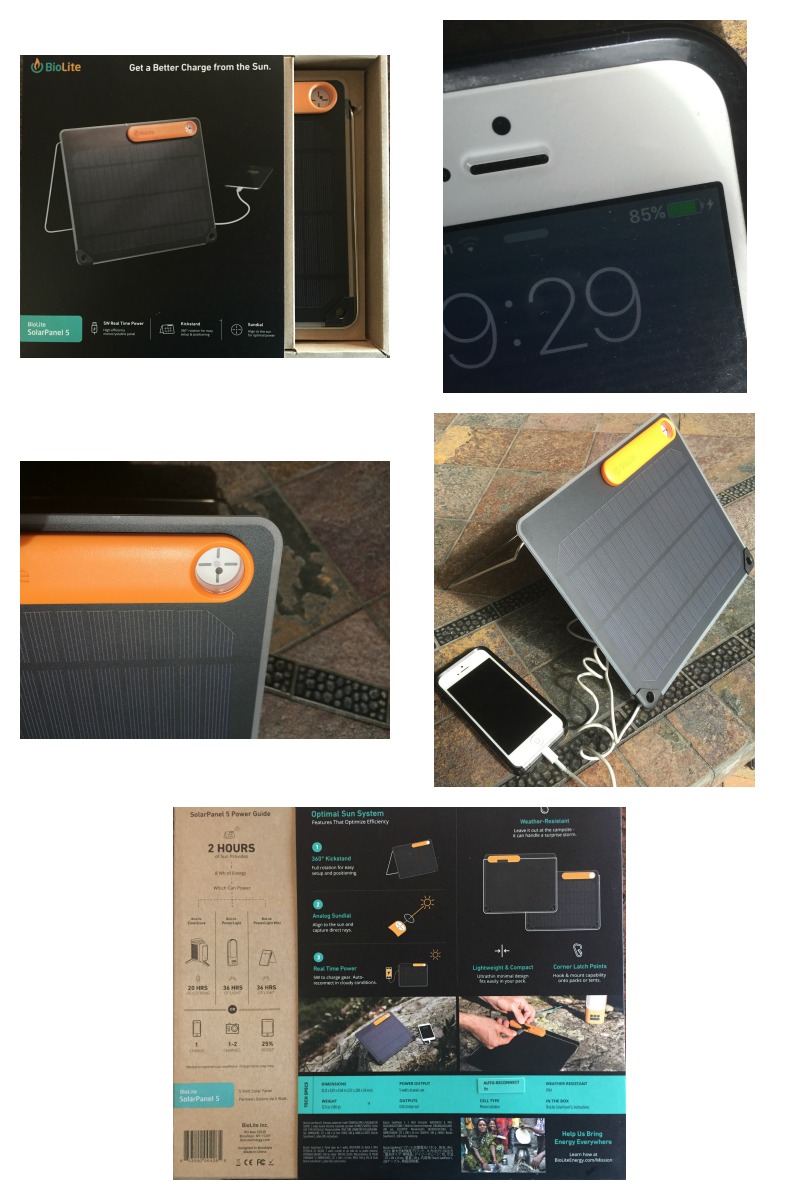
| Manufacturer: | BioLite Inc. |
| Manufacturer website: | http://www.bioliteenergy.com |
| Model: |
SolarPanel 5 |
| Year of manufacture: | 2016 |
| Country of origin: |
Designed in Brooklyn,
NY Manufactured in China |
| MSRP: |
$59.95 USD |
| Color tested: |
Only one color is available - as shown |
| Weight: |
Listed: 12 oz (340 g) Measured: 11.6 oz (329 g) |
| Dimensions: |
Listed: 10.12 x 8.19
x 0.94 in (257 x 208 x 24 mm) Measured: as listed, within my measurement accuracy |
| Warranty: |
One year from
purchase date |
| Materials: |
Cells:
Monocrystalline Metal kickstand |
| Date |
Location |
Trail |
Distance |
Altitude |
Weather |
Devices Charged |
| October 4-6, 2016 |
Aravaipa Canyon Wilderness |
Aravaipa Canyon |
21 miles (34 km) |
2550-3400 ft (840-1115 m) |
43-80 F (6-27 C) sunny |
iPhone 5, headlamp |
| October 15-16, 2016 |
Mogollon Rim north of Payson, Arizona |
none - car camp |
0 |
7400 ft (2260 m) |
45-75 F (7-24 C) |
iPhone 5 |
| November 10-11, 2016 |
Coronado National Forest, Santa Catalina
Mountains near Tucson, AZ |
Romero Canyon |
12 miles (19 km) |
2600-4800 ft (790-1460 m) |
40-75 F (4-24 C) Sunny with a light breeze |
iPhone 5 |
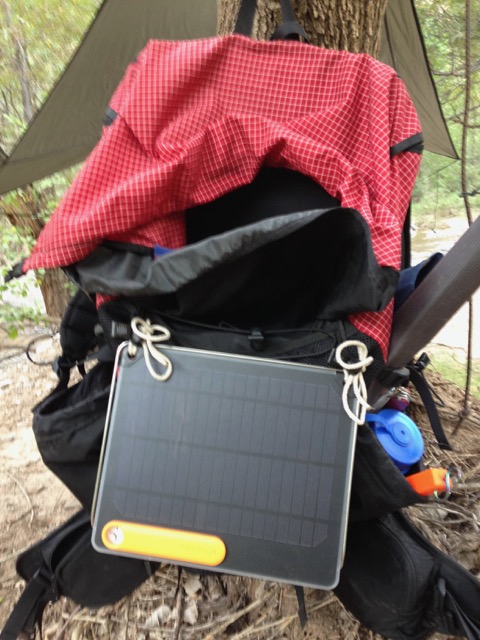 This 3-day backpack trip was my first attempt to use
the solar panel in the field. The photo at left shows the
panel attached to the back of my pack. The weather was bright
and sunny, but the canyon walls and occasional tree cover limited
the amount of direct sunlight.
This 3-day backpack trip was my first attempt to use
the solar panel in the field. The photo at left shows the
panel attached to the back of my pack. The weather was bright
and sunny, but the canyon walls and occasional tree cover limited
the amount of direct sunlight.This weekend outing was a "hammock hang", where hammock campers
congregate to compare gear, drink beer and talk around a
campfire. The site was a camp area up on the Mogollon Rim,
the edge of the Colorado Plateau in northern Arizona. The
campsite I chose was in an area of tall Ponderosa pines, but the
spot where I stashed my pack on top of a picnic table was in the
sun, so I thought I'd plug in my iPhone 5 to the solar panel for
charging. The following photos show the solar panel in the
sun, and a screen capture of my phone before and after charging.
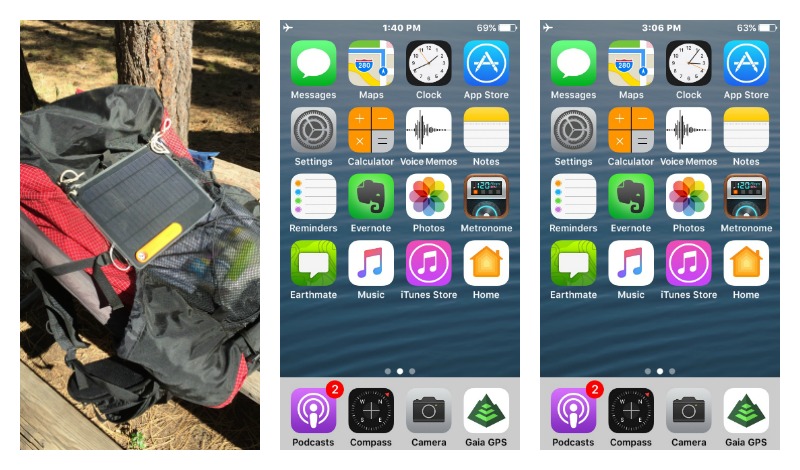
This was very disappointing. After over an hour in the sun,
in Airplane Mode (see the little airplane icon in the upper left
corner), my phone LOST 6% of its charge! How
could this be? I believe that as the panel went in and out
of the sun from its movement across the tree canopy that the
action the iPhone was taking to report that it was/was not
charging actually consumed more power than what was generated by
the panel.
I was getting a bit frustrated with the device, so I thought it
might be good to do a little more extensive backyard
testing. Plugged my iPhone 5 into the solar panel in my
backyard, set to Airplane AND Low Power mode (see the yellow
battery indicator in the photo below) and achieved a 16% charge in
about 50 minutes. Not bad. My takeaway is the device
needs to be in a consistently sunny spot and well-aimed for the
duration of the charge to attain the listed performance:
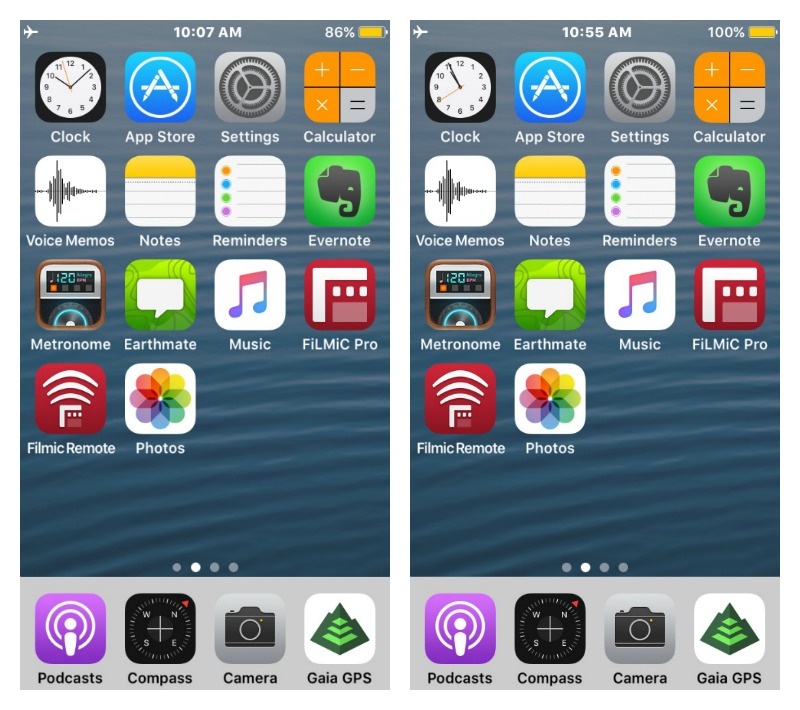
This was a one-night backpacking trip located near my home.
It's a short hike, but a tough one. I had my iPhone 5
plugged into the solar panel all the time I was on the trail, in
Airplane Mode.
On the way up the canyon, I could hear my phone constantly
"bonging" as the phone went in and out of charge state. The
net effect after five hours of hiking on a brilliant sunny Arizona
day was a 2% charge of my iPhone. I was pretty discouraged.
Before I set off on the way down I decided to set my phone on
"Silent" and "Vibrate off". It was the lowest power
consumption mode I could think of. I'd have no way of
knowing if the phone was charging or not, but it wasn't important
to me. I checked the power level before and after my hike,
and the net was a 21% charge over roughly five hours.
Woohoo!
My bottom line from what I have seen in the first two months of
use: the SolarPanel is most appropriate for basecamp use, not hung
from the front of a backpack while hiking.
| Date |
Location |
Trail |
Distance |
Altitude |
Weather |
Devices Charged |
| December 1-6, 2016 |
Grand Canyon National Park |
Escalante Route |
52 miles (84 km) |
256-7400 ft (780-2260 m) |
5-55 F (-15-13 C) sunny |
iPhone 5 |
The Escalante Route is one of the tougher hikes of the Grand
Canyon, running along the Colorado River from the Tanner to the
New Hance Trail. We decided that wasn't difficult enough, so
we tacked on several days of the Tonto Trail and exited the South
Kaibab.
In principle this should have been a good hike to use a solar charger: there are few trees to block the sun, and our route on the Escalante and Tonto is pretty much East to West, so mornings should have a fair sun exposure. The reality was quite different. I plugged in my iPhone 5 several times in the morning before setting off, and saw a charge of 5-10% during the morning hike. There were some days with a bit of a haze, but also the trails are rarely due West. They meander North and South to follow the cut of the canyons. Also, we were probably in shade about 50% of the time due to the buttes and other formations in conjunction with the low winter sun angle. The following photo shows the panel attached to my backpack near the intersection of the Tonto and South Kaibab trails.
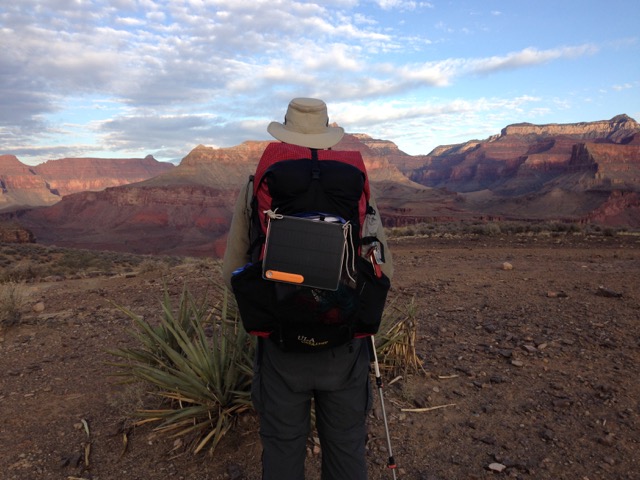
This was an arduous hike with some serious scrambling. The
panel sustained a few scratches, but managed to make the entire
journey and keep on kicking, which is no mean feat.
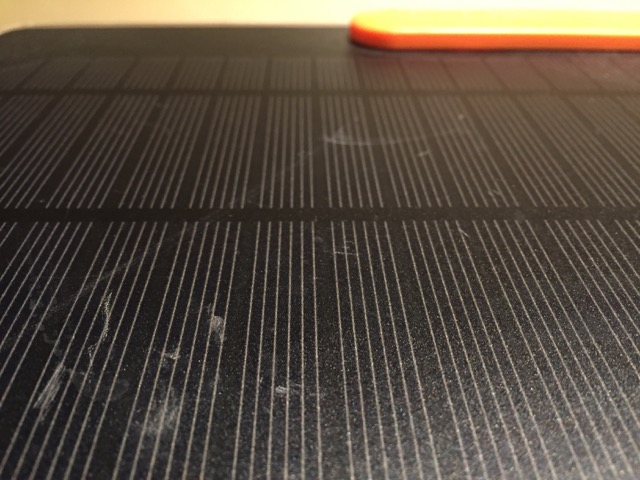 My experience during the second two
months reinforced my conclusion from the Field Report: this solar
panel is great for a basecamp application where it can be kept
well-aligned with the sun. It is not appropriate for
attaching to the back of one's pack during a hike and expecting to
get a serious amount of device charging.
My experience during the second two
months reinforced my conclusion from the Field Report: this solar
panel is great for a basecamp application where it can be kept
well-aligned with the sun. It is not appropriate for
attaching to the back of one's pack during a hike and expecting to
get a serious amount of device charging.
The device itself is quite mechanically robust and
reliable. I didn't baby it at all, and it really took a lot
of punishment on the Escalante. The front of my pack
suffered some tears along the front close to where the solar panel
was strapped to it, yet the charger continues to function.
The photo at left shows what the surface looked like at the end of
the test, just a few minor scratches. It looks much better
than my pack does!
Thanks to BackpackGearTest.org and BioLite for the opportunity to
contribute to this test.